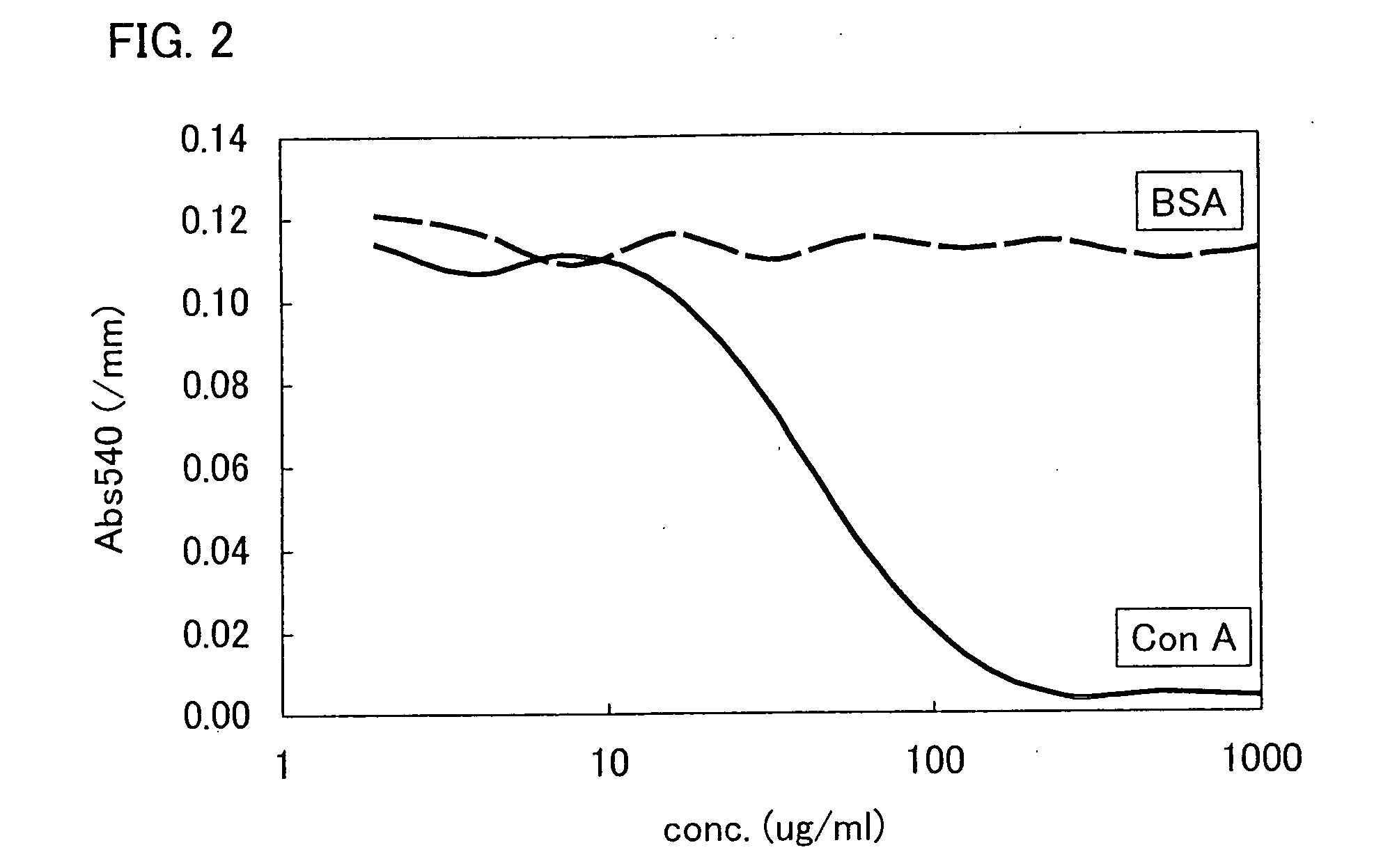Novel sugar-immobilized metal nanoparticle, method for measuring sugar-protein interaction using the same and method for recovering protein from sugar-protein interactant
a metal nanoparticle and sugar protein technology, applied in the field of sugar-immobilized metal nanoparticles, can solve the problems of affecting measurement variations, difficult to perform measurement conveniently, and require very expensive equipment, and achieve the effect of preparing the sugar chain
- Summary
- Abstract
- Description
- Claims
- Application Information
AI Technical Summary
Benefits of technology
Problems solved by technology
Method used
Image
Examples
example 1
Preparation of Maltose-Immobilized Gold Nanoparticles
[0106]Sodium chloroaurate (III) and sodium borohydride were vigorously stirred and mixed with water so that final concentrations of sodium chloroaurate (III) and sodium borohydride are 1 mM and 5 mM, respectively, thereby preparing a solution of gold nanoparticles. Ligand complex was a compound of thioctic acid, m-phenylenediamine, and maltose (mass ratio of 1:1:1). To the ligand complex, water was added to obtain a solution of ligand complex with a final concentration of 100 μM. The solution of ligand complex was added to the solution of gold nanoparticles. Then, the resulting mixture solution was vigorously stirred and mixed, thereby preparing a colloid solution of crude maltose-immobilized gold nanoparticles.
[0107]Next, the colloid solution of crude maltose-immobilized gold nanoparticles was transferred to a dialysis tube (MWCO:3,500) and subjected to dialysis with water and PBS-T (0.05%), thereby purifying the colloid solution...
example 2
Measurement of Sugar-Protein Interaction
[0108]Dilution series (PBS-T (0.05%)) of concanavalin A (hereinafter referred to as “ConA”; manufactured by EY Laboratories Inc.), which is a protein that recognizes maltose, and dilution series (PBS-T (0.05%)) of bovine serum albumin (hereinafter referred to as “BSA”; manufactured by SIGMA), which is a non-maltose-recognizing protein, were placed at 10 μM and lower concentrations on 96-well titer plate (25 μl per well). Then, the colloid solution of maltose-immobilized gold nanoparticles was added to each of the diluents so that a ratio between the colloidal solution and the diluent is 1:1. The resulting mixture solution was left for 30 minutes to 2 hours. After aggregation of the maltose-immobilized gold nanoparticles was completed, the result was evaluated by visual observation and measurement of ultraviolet-visible absorption spectrum (540 nm).
[0109]FIG. 2 is an ultraviolet-visible absorption spectrum showing sugar-protein interaction betw...
example 3
Recovery of ConA from Sugar-Protein Interactant
[0112]100 μl of PBS-T (0.05%) solution containing ConA at 250 μg / ml was placed in an Eppendorf tube. To the solution was added 100 μl of the colloid solution of maltose-immobilized gold nanoparticles which was prepared in Example 1. Then, a mixture solution was vortexed for at least 10 seconds. Thereafter, the resulting mixture solution was left for approximately 2 hours, and a sugar-protein interactant was precipitated out of the mixture solution by centrifugation. Then, supernatant thereof was removed, and the sugar-protein interactant was washed with PBS-T (0.05%) solution and water several times. After the washing, 100 μl of 200 mM glucose aqueous solution was added to the sugar-protein interactant, and the resulting mixture solution was left for approximately 1 hour. The result was evaluated by (i) visually observing return of ConA from the sugar-protein interactant to the colloid solution of maltose-immobilized gold nanoparticles ...
PUM
| Property | Measurement | Unit |
|---|---|---|
| molar concentration | aaaaa | aaaaa |
| molar concentration | aaaaa | aaaaa |
| pH | aaaaa | aaaaa |
Abstract
Description
Claims
Application Information
 Login to View More
Login to View More - R&D
- Intellectual Property
- Life Sciences
- Materials
- Tech Scout
- Unparalleled Data Quality
- Higher Quality Content
- 60% Fewer Hallucinations
Browse by: Latest US Patents, China's latest patents, Technical Efficacy Thesaurus, Application Domain, Technology Topic, Popular Technical Reports.
© 2025 PatSnap. All rights reserved.Legal|Privacy policy|Modern Slavery Act Transparency Statement|Sitemap|About US| Contact US: help@patsnap.com



